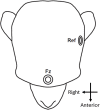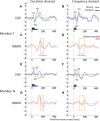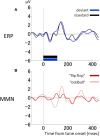Translatability of Scalp EEG Recordings of Duration-Deviant Mismatch Negativity Between Macaques and Humans: A Pilot Study
- PMID: 33005162
- PMCID: PMC7479845
- DOI: 10.3389/fpsyt.2020.00874
Translatability of Scalp EEG Recordings of Duration-Deviant Mismatch Negativity Between Macaques and Humans: A Pilot Study
Abstract
Mismatch negativity (MMN) is a negative deflection of the auditory event-related potential (ERP) elicited by an abrupt change in a sound presented repeatedly. In patients with schizophrenia, MMN is consistently reduced, which makes it a promising biomarker. A non-human primate (NHP) model of MMN based on scalp electroencephalogram (EEG) recordings can provide a useful translational tool, given the high structural homology of the prefrontal and auditory cortices between NHPs, such as macaques, and humans. However, in previous MMN studies, the NHP models used did not allow for comparison with humans because of differences in task settings. Moreover, duration-deviant MMN (dMMN), whose reduction is larger than that in the frequency-deviant MMN (fMMN) in patients with schizophrenia, has never been demonstrated in NHP models. In this study, we determined whether dMMN can be observed in macaque scalp EEG recordings. EEGs were recorded from frontal electrodes (Fz) in two Japanese macaques. Consistent with clinical settings, auditory stimuli consisted of two pure tones, a standard and a deviant tone, in an oddball paradigm. The deviant and standard tones differed in duration (50 and 100 ms for the standard and deviant tones, respectively). A robust dMMN with a latency of around 200 ms, comparable to that in humans, was observed in both monkeys. A comparison with fMMN showed that the dMMN latency was the longer of the two. By bridging the gap between basic and clinical research, our results will contribute to the development of innovative therapeutic strategies for schizophrenia.
Keywords: animal model; electroencephalogram (EEG); macaque; mismatch negativity; schizophrenia.
Copyright © 2020 Tada, Suda, Kirihara, Koshiyama, Fujioka, Usui, Araki, Kasai and Uka.
Figures





Similar articles
-
Auditory mismatch negativity and P3a in response to duration and frequency changes in the early stages of psychosis.Schizophr Res. 2013 Nov;150(2-3):547-54. doi: 10.1016/j.schres.2013.08.005. Epub 2013 Sep 6. Schizophr Res. 2013. PMID: 24012461
-
Auditory pre-attentive processing of Chinese tones.Chin Med J (Engl). 2008 Dec 5;121(23):2429-33. Chin Med J (Engl). 2008. PMID: 19102963 Clinical Trial.
-
Test-retest reliability of duration-related and frequency-related mismatch negativity.Neurophysiol Clin. 2021 Dec;51(6):541-548. doi: 10.1016/j.neucli.2021.10.004. Epub 2021 Nov 5. Neurophysiol Clin. 2021. PMID: 34750039
-
Mismatch negativity (MMN) as a tool for translational investigations into early psychosis: A review.Int J Psychophysiol. 2019 Nov;145:5-14. doi: 10.1016/j.ijpsycho.2019.02.009. Epub 2019 Mar 1. Int J Psychophysiol. 2019. PMID: 30831138 Review.
-
Cerebral generators of mismatch negativity (MMN) and its magnetic counterpart (MMNm) elicited by sound changes.Ear Hear. 1995 Feb;16(1):38-51. doi: 10.1097/00003446-199502000-00004. Ear Hear. 1995. PMID: 7774768 Review.
Cited by
-
Prediction-Related Frontal-Temporal Network for Omission Mismatch Activity in the Macaque Monkey.Front Psychiatry. 2022 Apr 26;13:557954. doi: 10.3389/fpsyt.2022.557954. eCollection 2022. Front Psychiatry. 2022. PMID: 35558420 Free PMC article.
-
Why mismatch negativity continues to hold potential in probing altered brain function in schizophrenia.PCN Rep. 2023 Sep 24;2(3):e144. doi: 10.1002/pcn5.144. eCollection 2023 Sep. PCN Rep. 2023. PMID: 38867817 Free PMC article. Review.
-
Change detection in the primate auditory cortex through feedback of prediction error signals.Nat Commun. 2023 Nov 13;14(1):6981. doi: 10.1038/s41467-023-42553-3. Nat Commun. 2023. PMID: 37957168 Free PMC article.
-
Complementary functional profiles of mismatch responses mediated by adaptation and deviance detection point to two distinct auditory short-term memory systems.J Neurophysiol. 2025 Jul 1;134(1):314-336. doi: 10.1152/jn.00515.2024. Epub 2025 Jun 9. J Neurophysiol. 2025. PMID: 40490293 Free PMC article.
References
LinkOut - more resources
Full Text Sources
Miscellaneous

